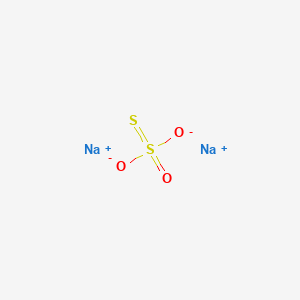Cyanide poisoning
Adult: For sequential use with sodium nitrite: As 250 mg/mL solution: 12.5 g (50 mL) via slow IV inj over 10 minutes, administered immediately after sodium nitrite. If signs or symptoms of cyanide toxicity recur, treatment with sodium nitrite and sodium thiosulfate may be repeated at half the initial doses. Treatment recommendations may vary among countries and individual products (refer to local or specific product guidelines).
Child: For sequential use with sodium nitrite: As 250 mg/mL solution: 250 mg/kg (1 mL/kg) via slow IV inj. Alternatively, 412.5 mg/kg (1.65 mL/kg) via slow IV inj. Doses are administered immediately after sodium nitrite. Max total dose: 12.5 g (50 mL). If signs or symptoms of cyanide toxicity recur, treatment with sodium nitrite and sodium thiosulfate may be repeated at half the initial doses. Dosage and treatment recommendations may vary among countries and individual products (refer to local or specific product guidelines).
Child: For sequential use with sodium nitrite: As 250 mg/mL solution: 250 mg/kg (1 mL/kg) via slow IV inj. Alternatively, 412.5 mg/kg (1.65 mL/kg) via slow IV inj. Doses are administered immediately after sodium nitrite. Max total dose: 12.5 g (50 mL). If signs or symptoms of cyanide toxicity recur, treatment with sodium nitrite and sodium thiosulfate may be repeated at half the initial doses. Dosage and treatment recommendations may vary among countries and individual products (refer to local or specific product guidelines).
Intravenous
Risk reduction of cisplatin-induced ototoxicity
Child: ≥1 month As 125 mg/mL solution: In patients with localised, non-metastatic solid tumours who are receiving cisplatin infusions with ≤6 hours duration: Patients weighing <5 kg: 10 g/m2; 5-10 kg: 15 g/m2; >10 kg: 20 g/m2. All doses are given via IV infusion over 15 minutes beginning 6 hours after completion of cisplatin infusion. If cisplatin is a multiday regimen, give sodium thiosulfate 6 hours after completion of each cisplatin infusion and at least 10 hours before the next cisplatin dose; do not administer sodium thiosulfate if the next cisplatin dose is due in <10 hours. Administer antiemetics before each sodium thiosulfate dose. Dosage recommendations may vary among countries; dosing interruption or discontinuation may be required according to the severity of adverse reactions (refer to detailed product guidelines).




 Sign Out
Sign Out




